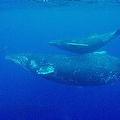 美國聯邦政府1月12日對海軍發佈,未來5年內在夏威夷島區域執行聲納訓練時可以衝擊海豚和鯨魚,這份許可文件允許高達11種動物各10隻以內的傷害或是殺害。
美國聯邦政府1月12日對海軍發佈,未來5年內在夏威夷島區域執行聲納訓練時可以衝擊海豚和鯨魚,這份許可文件允許高達11種動物各10隻以內的傷害或是殺害。
海軍之所以要求這份由海洋哺乳動物保護法案之下的許可文件,是因為由戰術聲納(tactical active sonar)所產生的中頻聲壓和爆炸產生的聲音和壓力,可能影響某些海洋哺乳動物的行為,或是如海軍所說的「暫時喪失了他們的聽力」。
中頻聲納可以傳送連續性高於235分貝的聲波,這樣的強度和火箭發射升空差不多,可以使數百英里的海面下為之震盪,連潛水艇都會被影響。
美國國家海洋暨大氣總署漁業署(NOAA's Fisheries Service)發表了這份許可,表示這樣的頻率不會造成海洋哺乳類的嚴重傷亡,但是該單位也承認暴露在聲納之下和造成海洋哺乳類動物的擱淺有關,而傷亡亦可能由此發生。
漁業署決議這些因素對於該區域的生物是微不足道的影響因素。
而美國國家海洋暨大氣總署(NOAA)指出的保護手法,是要求海軍在每一個使用聲納的船隻周遭成立海洋哺乳類安全區,如果在安全區內見到海洋哺乳類就需要關掉聲納系統。
海軍必須使用非保護區來引爆爆炸,如果可以確保在一定距離內不會偵測到動物。
海軍也需要實行擱淺回應計畫,包含在某些情形降低防備等級的訓練,如果美國國家海洋暨大氣總署漁業署參與執行的擱淺回應和調查,則海軍需以實質物品回饋其協議之備忘錄。
在茂伊島盆地(Maui Basin)這條法規特別受到重視,因為其擁有相當密集的座頭鯨(humpback whale),夏威夷島國家海洋保護區包含了茂伊島的四個小島,企鵝沙洲和可愛島北岸的延伸區域,瓦胡島的北岸和南岸,大島上的北科那和科哈拉海岸。
夏威夷是美國唯一的座頭鯨繁殖、生產和培育他們的下一代的地方,每年冬天差不多4000到5000隻的鯨魚遷徙到夏威夷島,儘管座頭鯨的數量在增加之中,這些鯨魚仍然是瀕臨絕種之中。
美國國家海洋暨大氣總署漁業署1月12日表示這些措施應該可以將傷亡的可能降到最低,並明顯地減少海洋哺乳動物暴露的程度,及造成聽覺暫時喪失的數量。
但是環保人士不同意這一點。「美國國家海洋暨大氣總署漁業署的角色,是保護海洋動物的健康和福利,但是他們在這個許可文件上怠忽職守了。」國家資源保衛協會(Natural Resources Defense Council)的律師齊考(Taryn Kiekow)這樣表示,這個非營利組織長期以來和海軍有一系列的法律訴訟,以對抗海軍使用對海豚和鯨魚造成負面影響的聲納系統。
The federal government today issued authorization to the U.S. Navy to impact whales and dolphins while conducting sonar training exercises around the main Hawaiian Islands for the next five years. The letter of authorization and accompanying rules allow for injury or death of up to 10 animals of each of 11 species over the five years covered by the regulations.
The Navy requested authorization under the Marine Mammal Protection Act because the mid-frequency sound generated by tactical active sonar, and the sound and pressure generated by detonating explosives, may affect the behavior of some marine mammals or cause what the Navy calls "a temporary loss of their hearing."
Mid-frequency sonar can emit continuous sound well above 235 decibels, an intensity roughly comparable to a rocket at blastoff across hundreds of miles of ocean to reveal objects, such as submarines, underwater.
NOAA's Fisheries Service, which issued the authorization says serious injury or death to marine mammals is not expected as a result of the exercises. But the agency acknowledges that exposure to sonar has been associated with the stranding of some marine mammals, and some injury or death could occur.
The Fisheries Service has determined that these effects would have "a negligible effect on the species or stocks involved."
Protective measures outlined by NOAA require the Navy to establish marine mammal safety zones around each vessel using sonar and shut down sonar operations if marine mammals are seen within designated safety zones.
The Navy must use exclusion zones to ensure that explosives are not detonated when animals are detected within a certain distance.
The Navy must implement a stranding response plan that includes a training shutdown provision in certain circumstances and a memorandum of agreement to allow the Navy to contribute in-kind services to NOAA's Fisheries Service if the agency has to conduct a stranding response and investigation.
The regulations establish an area of extra caution in the Maui Basin because of its high density of humpback whales. The Hawaiian Islands National Marine Sanctuary covers the four island area of Maui; Penguin Bank; and extends off the north shore of Kauai, the north and south shores of Oahu, and the north Kona and Kohala coasts of the Big Island.
Hawaii is the only place in the United States where humpbacks breed, calve, and nurse their young. Approximately 4,000-5,000 whales migrate to the Hawaiian Islands each winter. Although the population of humpbacks is increasing, these whales remain endangered.
NOAA Fisheries Service said in a statement today that these measures "should minimize the potential for injury or death and significantly reduce the number of marine mammals exposed to levels of sound likely to cause temporary loss of hearing."
But environmentalists disagree.
"The role of the National Marine Fisheries Service is to protect the health and welfare of marine mammals and they are abdicating their duty with this authorization," said Taryn Kiekow, marine mammal staff attorney with the Natural Resources Defense Council. The nonprofit organization has fought a series of legal battles against the Navy's use of sonar due to its adverse effects on whales and dolphins.


